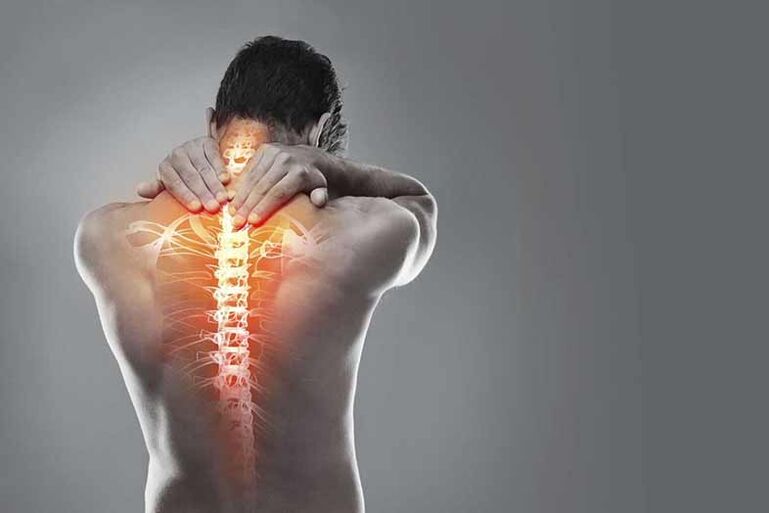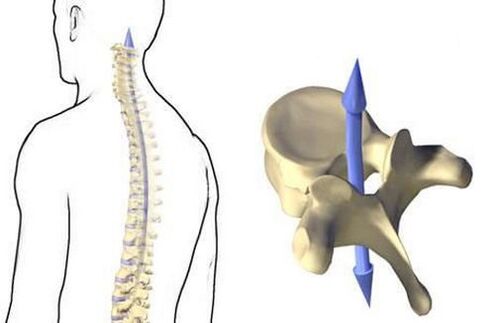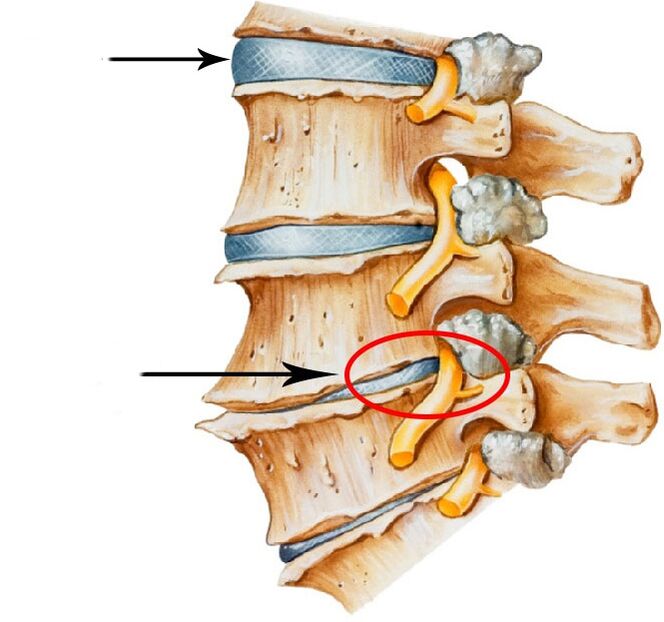
According to statistics, almost half of the people from 30 to 55 years suffered from osteochondrosis.The lowest age threshold of the disease in recent years has decreased to 18 years.
What is osteochandrosis?
Column osteochondrosisIt is expressed in the defeat of the intervertebral disc, which loses its elasticity, elasticity, cracks.
Cervical osteochondrosisassociated with damage to discs in the cervical column.
How the spine works
If for a better understanding, the essence simplified, then the column device can be described as follows.
The column consists of separately, similar to each other in the form of vertebrae located above the other.
Despite some differences in the form, in the structure of all vertebrae there is a common.There is a hole in each vertebra: all holes are also above the other and form a vertical channel (tunnel) that passes throughout the spine.
Within this spinal channel, the spinal cord passes.It goes vertically through the holes in each vertebra, and their roots (branches, in which sensitive nerve endings) leave the channel between each pair of vertebrae.This is possible because the vertebrae do not miss each other and do not hold well, and between each pair of vertebrae there is a cartilage: an intervertebral disc.

The wheels together with the ligaments connect the vertebrae with each other and also play the role of the shock absorber.Due to their elastic structure, they are elastic compressed during the movements and inclinations of the body (from the side of the inclination) or without silence (by straightening).Therefore, the discs provide the spine with flexibility and soften the load of the vertical pressure from top to bottom to each vertebral vertebra of the spinal column, as well as the upward vertical vibrations that occur when walking or running.After all, a person is an erect and direct creature.
Such column work is guaranteed if the entire load is distributed correctly.Nature has created the incredibly stable, resistant and at the same time flexible backbone.
What if not?
If the shape of the spine is violated, conceived by nature, for some reason (inclined, excessive curve in the lower back, scoliosis, flat feet) or a constant chronic habit of sitting, lying, standing, intervertebral compounds begin to wear out, lose their elasticity, the ability to perform the taste of flavor flavor, they are flavored, crackled, crackled and crushedDeformed.They climb to the sides, forming a hernia.
The wear of the intervertebral discs: there is also a recognition of a person to vertical.After all, only in humans the spine has a vertical load.Such vertical compression throughout the life of all components of the spine (especially in people with excess weight) leads to a gradual deterioration in the blood supply to the intervertebral discs (the vascular direction is squeezed): the album loses resistance and strength.
What follows?

HERNIA DISK PRESSBlood vessels,Nerve rootsAnd sometimesspinal cord.
The consequences of cervical osteochondrosis
Due to changes in anatomical proportions in the spine, blood vessels (the main arteries and veins) are squeezed.
What is happening:Due to changes in anatomical proportions in the spine, blood vessels (the main arteries and veins) are squeezed.What leads to:
- to a violation of the blood flow to the brain and a violation of a complete nutrition of the brain.
- to a violation of the venous output and the accumulation of toxic substances in the brain tissues.
How it manifests:
- Dizziness (until short -term loss of consciousness).
- Headaches
- Visual disability.Smell violation, flavor.
- Bulbar disorders associated with the difficulties of swallowing, pronunciation, violation of general breathing and speech.
- Cognitive disorders: deteriorated memory, perception, complexity with concentration of attention, complexity with logical thinking.Reading violation.
- Absent -Mida.Inappropriation.Decrease in confusion.Forgot.
- Difficulties to pronounce complex and long words, complex grammatical constructions.
- Reduced performance, excess work.
- Violations in the emotional and personal sphere: acute and unreasonable humor changes, emotional incontinence, irritability, anger.
DIAGNOSTICS: Cognitive disorders, aphasia, bulbar dysarthria, discirculatory encephalopathy, vertebro-boo (VBN) insufficiency, etc.They can be diagnosed. Pharmacological therapy taken in these cases:
- Vascular drugsThey have an extremely low base basis.They require the use of the doctor and under the control of a doctor, they can cause a lot of complications and different side effects.
- Nootropic medications.It requires strictly using for the appointment and under the control of a doctor.Many have quite serious contraindications of the cardiovascular system (with hidden heart pathology, they can cause serious negative consequences).Most notropos do not have a positive pharmacological result, that is, it is useless.
- Drugs with sedative effect, including tranquilizers, antidepressants, barbiturates, bromides.Psychotropic drugs.It requires strictly using for the appointment and under the control of a doctor.They can be addictive and have multiple side effects (dizziness, headaches, visual disability and urine, dry mouth, nausea, etc. disorders of misfortune, a decrease in libido, sleep disorders, a set of body weight).
There is a squeeze (compression) of nerve roots, the nerves from the spinal cord to the organs and tissues of the upper body.
What is happening:
There is a squeeze (compression) of nerve roots, the nerves from the spinal cord to the organs and tissues of the upper body.
What leads to: To a pronounced pain syndrome, often chronic, recurring.
How it manifests:
- Neck pain, the back of the head (with head tours or at rest, shots or chronic).
- The headache (tension headache associated with the tension of the muscles of the posterior surface of the neck and head of the head: pain, poured over the head, often accompanied by noise and sounding in the ears, flies in front of the eyes).
- Pain in the upper chest.
- Pains that simulate pain in the heart, in the lungs.
- Pain at the top of the back on the shoulders, shoulders.
- Shoulder joint pain or all hand.
- Numbness of fingers, hands, hands completely.
Pharmacological therapy taken in these cases:
- Non -steroidal anti -inflammatory drugs (analgesics, antipyretics), which require the use of strictly for the appointment and under the control of a doctor and have negative lateral reactions of the gastrointestinal tract (gastritis, ulcers, ulcerative bleeding), cardiovascular system, kidneys.
- Preparations that relieve muscle hypertonicity, which require strictly use for their planned purpose and under the control of a doctor and have lateral negative reactions in the form of strong dizziness, weakness until completely exhausting.
The use of pharmacological therapy is the most common practice in the treatment of osteochondrosis.However, this is a symptomatic treatment.Medications are used to stop inflammatory processes and pain (sometimes it has to resort to the novocaine block), a decrease in neurological and psychomocional symptoms.The most important thing is that pharmacological therapy occurs under the strict supervision of a doctor.
However, if it does not directly stop the process of violation of the vessels, it does not restore the balance of the column and all the related structures established by nature (the violation of the symmetry of the body, the flat feet, the muscle cramps that occur as a compensatory reaction to the balance), the disease will not go anywhere and at some point it will not help and should not help and should resort to the operation.
The osteopathic treatment aims to eliminate the previous causes of osteochondrosis, which today is recognized as the most effective.
Osteopathic treatment of osteochandrosis
Rule No. 1 "The sooner, the better" in the case of osteochondrosis, it works especially!After all, healing the osteochondrosis, it means not extinguishing pain or other syndromes, but to restore the normal position of the spine, to provide the intervertebral disc with complete lost nutrition (to return the normal blood supply) even before the degenerative processes in the cartilaginous tissue become irreversible.
The osteopath determines the place where displacement or deformation has occurred, findsThe reasons why the vessels of the containers occurred in the spine.Osteopathy considers that the body is a single system in which everything is interconnected and affects each other, literally pulls one after another.This means that the osteopata restores the work of all structures, the changes in which in the chain led to a violation of the power of the intervertebral disc.The task of the osteopath is to restore the balance and tissue balance relationship, eliminate stress and clamps that interfere with complete nutrition.And if, in the case of a careless condition of the disease, the changes in the structure of the column implied a violation of the work of the internal organs, the osteopathic treatment will be aimed at eliminating emerging dysfunctions.
That is, the osteopath works with the root cause of the disease, and not with the elimination of its syndromes, including pain.Although his work will begin with this, with the relief of pain.However, it will not stop there.The best form of osteopathy works in combination with physiotherapy (guarantees a decrease in pain and inflammatory processes) and physiotherapy exercises: exercise therapy (strengthens muscle corset, helps the body to remain in a new unusual, but adequate position).
Conclusions
- The neck cannot be treated frivolously.Since the brain must be provided with nutrition without obstacles.And it depends on how much the neck is a healthy "driver".
- You can't wait.The more the disease is launched, the more difficult it is to reverse it (and sometimes impossible).The osteopath can determine the disease when it is still in the rudiment and does not manifest in any way.You should never neglect a diagnostic exam.
- It is impossible to neglect the prevention of osteochondrosis.It is always easier than treating the disease.

























